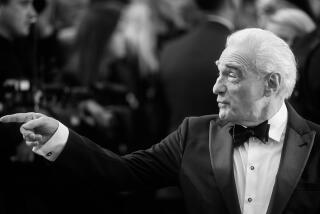For a Few Scenes More
- Share via
With “The Good, the Bad and the Ugly”--Sergio Leone’s most famous spaghetti western, starring Clint Eastwood--being released on DVD (digital video disc) today, fans will finally get to see several scenes that were cut from the original 1966 Italian version.
While the new footage doesn’t provide any startling revelations, it illustrates certain subtleties of character displayed by Eastwood and his two co-stars, Eli Wallach and Lee Van Cleef. They’re no longer just predictable icons in Leone’s director’s cut.
However, in an ironic twist, the result of this exclusive find for the fledgling home video format mirrors the film’s sardonic title.
While it’s good that MGM Home Entertainment has released this rarity (thanks to the tenacity of editor Glenn Erickson), the bad news is that the extra footage--which exists only in Italian--has been included as a supplement. And viewing the seven Italian scenes (which total about 14 minutes in length) can be a little ugly, considering DVD’s rather cumbersome menu and scene selection access. Unlike laserdiscs, for example, you first must activate the English subtitle option to understand the footage (unless, of course, you’re familiar with Italian and can additionally lip-read Eastwood, Wallach and Van Cleef).
Still, it’s well worth the effort, not only because this is such an important and downright enjoyable film, but with DVD, you get such a superior home video viewing experience. (They’ve even managed to fit it all on one side of the disc, utilizing both layers without any compression kinks--impressive since the film runs nearly three hours.)
Also, given his spectacular trademarks, Leone is such a natural for DVD. Those arid panoramic vistas are so vibrant and sharp in this wide-screen edition--a must for appreciating how his camera encircles the characters with an operatic fatalism. And those gargantuan close-ups are so intense, detailing the emotional abstractions on their faces.
Plus, DVD enhances Ennio Morricone’s celebrated music score--so integral to Leone’s work--featuring the composer’s signature “hyena’s cry” theme, which probably hasn’t sounded this good on home video before.
Seeing the film again, it becomes clear that Leone’s surreal transposition of the western doesn’t seem as strange as it once did--just ornately Italian. Remember, this artistic explosion occurred years before Sam Peckinpah’s “The Wild Bunch,” which was released in 1969. (Leone’s film wasn’t released in the U.S. until 1967, a year after the original Italian version.)
*
For Leone, “The Good, the Bad and the Ugly,” the final installment of “The Man With No Name” trilogy, really represents his first ambitious effort. It isn’t merely longer and more expensive than “A Fistful of Dollars” and “For a Few Dollars More,” the pace is slower and more deliberate, and the Civil War-era story about the search for $200,000 in gold is more character-driven.
The stoic and sarcastic Eastwood obviously refined his persona here, portraying a bounty hunter who plays a con game with Wallach, a wily and foul-mouthed bandit. When Eastwood tries to break up the act, Wallach kidnaps and torments him in the desert, until they stumble on the whereabouts of the buried treasure, with each possessing a piece of the puzzle. All the while, the menacing and brutal Van Cleef has been on the trail of the money as well.
Eventually their paths cross with geometric certainty, and Eastwood plays his two adversaries off each other, gaining sweet revenge in more ways than one. That final three-way duel in the graveyard, by the way, establishes Leone once and for all as a formidable stylist, creating a kind of languid tension by cutting back and forth between their eyes and hands.
The first of the new scenes, in which Van Cleef stalks the Confederate officer who has stashed the gold, finds him exploring a Rebel fort, gazing upon the wounded and dying soldiers with empathy. The scene slowly unfolds in typical Leone fashion, with a new lyrical theme introduced by Morricone.
The next couple of scenes elaborate on Wallach’s slow torment of Eastwood, who had never been this vulnerable before, as they reverse roles in their continual power struggle. Talk about co-dependence! (Curiously, as Erickson writes in his Video Savant Web site, the actor dubbing The Man With No Name sounds more like Marcello Mastroianni than Eastwood.)
*
The only other significant scene has Eastwood waking up and shooting a member of Van Cleef’s gang. When the villain remarks that now his gang numbers six, Eastwood delivers one of his trademark quips--that six is the perfect number--while reloading his six-shooter.
(Unfortunately, there is one omission from the DVD supplement: the torturing of Wallach in the prison camp, which runs nearly two minutes longer in the Italian version. Only the audio exists. Apparently there’s a little more brutality.)
Bring on the rest of Leone on DVD. Who knows what surprises they’ll find in his other masterpieces?


